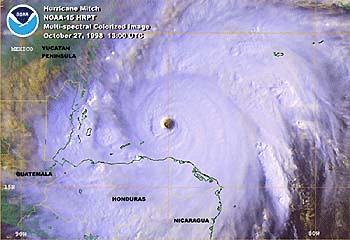Hurricane Mitch, the damage and destruction report!

Following are reports of the damage and destruction left by Mitch from each country affected: (from http://www.ncdc.noaa.gov/ol/ reports/mitch/ mitch.html)
HONDURAS:
Entire country affected.
Human toll:
An estimated 6,500 dead with up to 11,000 still missing. Up to 1.5 million people displaced and homeless. Critical food, medicine, and water shortages. Hunger and near-starvation widespread in many villages. Epidemics feared as malaria, dengue, and cholera make appearance. Fever and respiratory illnesses widespread. Helicopters required to take supplies to areas cut off by floods, but were in short supply. Some survivors still reported clinging to roof tops, and isolated areas of Honduras had not received help as late as November 12. At least 20% of country's population now homeless. Many of the unidentified dead were being buried in mass graves or their bodies were cremated. Tegucigalpa Mayor Cesar Castellanos, a likely candidate for Honduras' presidency in elections in 2001, and three others were killed when their helicopter crashed while surveying flood damage on Sunday, November 1. On Wednesday, November 4, the U.S. Coast Guard called off its search for the schooner "Fantome" after debris and life jackets were found. Thirty-one members of the crew were presumed lost after the captain tried to shield the boat from Mitch by sailing south of Guanaja Island. The last contact from the ship was on October 27.
Structural damage:
Infrastructure devastated. Whole villages washed away. Estimated 70 - 80 percent of transportation infrastructure destroyed. The majority of the country's bridges and secondary roads washed away. Even airports were under water. Helicopters were required for most rescues and aid because of transportation difficulties; communications disrupted. Fuel, electricity and running water scarce commodities. Damage so severe it may take 15 years to 20 years or more to rebuild. Some buildings 350 years old in capital city of Tegucigalpa were reported to be washed away completely. One third of all buildings in the capital were damaged by the floods. In outlying areas, over 25 small villages in the northern part of the country were swept away. Survivors were still clinging to roof tops a week or more after the storm. Heavy damage along coastline and off-shore islands from storm surge and hurricane-force winds. Severe damage inflicted on tourist resorts. Damage estimates of four billion dollars in Honduras alone.
Crop damage:
At least 70 percent of crops destroyed, including 80 percent of the banana crop. Crop losses estimated at $900 million. Large warehouses and storage rooms for coffee flooded. Maize and corn crops devastated. The damage by Mitch to Honduran agricultural production will take years for recovery.
NICARAGUA:
Northwest parts and northern parts of country most affected.
Human toll:
An estimated 3800 dead with perhaps as many as 7,000 others still missing. Two million people directly affected and 500,000 - 800,000 homeless. Intense near-stationary rain bands over western Nicaragua on Thursday and Friday (October 29-30) caused tens of inches of rain to fall. The crater lake atop the dormant Casita volcano filled and part of the walls collapsed on Friday, October 30, causing mud flows that eventually covered an area ten miles long and five miles wide. At least four villages were totally buried in the mud that was several feet deep. Over 2,000 of the dead were from the areas around the collapsed volcano near Posoltega. In many cases, survivors had to wait days before the mud had dried enough to walk to rescuers. Damage was extensive from flooding in other parts of the country, also. As late as November 8, over a thousand people were in urgent need of supplies on the Coco River near the border with Honduras. Earlier, on Thursday, November 5, five hundred bodies were found in the same river near the town of Wiwili. An additional five hundred unidentified bodies had washed up on the Pacific shore after flood waters had washed their bodies out to sea. As with Honduras, there were critical food and water shortages in flooded areas.
Structural damage:
Infrastructure in affected regions devastated. Several villages buried under mud slides near the Casita Volcano. Damage estimates for Nicaragua are at $1 billion. Damage considered worse than in the 1972 Managua earthquake. Damage to a half million homes and 750,000 people lost their homes or possessions.
Crop damage:
Thirty percent of coffee crop destroyed according to preliminary reports. Beans, sugar, and banana crops devastated.
Other Countries:
El Salvador: Western part of country most affected by rain bands spiralling into Mitch from the Pacific Ocean. 230 dead. 500,000 forced from their homes by flooding. As much as 80% of maize crop lost. Coffee plantations and sugar cane crop severely affected.
Guatemala: Over 200 killed by floods. Ten U.S. citizens and one other person killed in plane crash supplying humanitarian aid on Sunday, November 1. Near 80,000 evacuated from their homes by flooding. Nearly 1 million directly affected by Mitch. Extensive damage to coffee and banana plantations.
Costa Rica: Seven reported killed by flooding, mostly in the northeastern part of the country. Few thousand forced from their homes.
Belize: Eleven dead or missing. Flood and crop damage extensive. Most of Belize City evacuated on October 28 as Mitch threatened to hit the city as at least a Category 4 storm. Had this occurred, it might have been similar to the Hurricane Hattie disaster of October 31, 1961 when Belize City was virtually destroyed and as a result the capital was moved inland to Belmopan. With Mitch stalling well east of Belize City, the disaster was not repeated and most of Mitch's damage was from flooding.
Mexico: Nine reported killed. Five died near Tapachula in
southern Mexico near the Guatemalan border when their car was washed
from the road. A U.S. citizen was killed near Cancun in a boating
accident. Though ocean swells hit the Mexican tourist meccas of Cancun
and Cozumel, they were largely unaffected. Many tourists cancelled
reservations, however, when it appeared Mitch was poised to strike the
Yucatan.